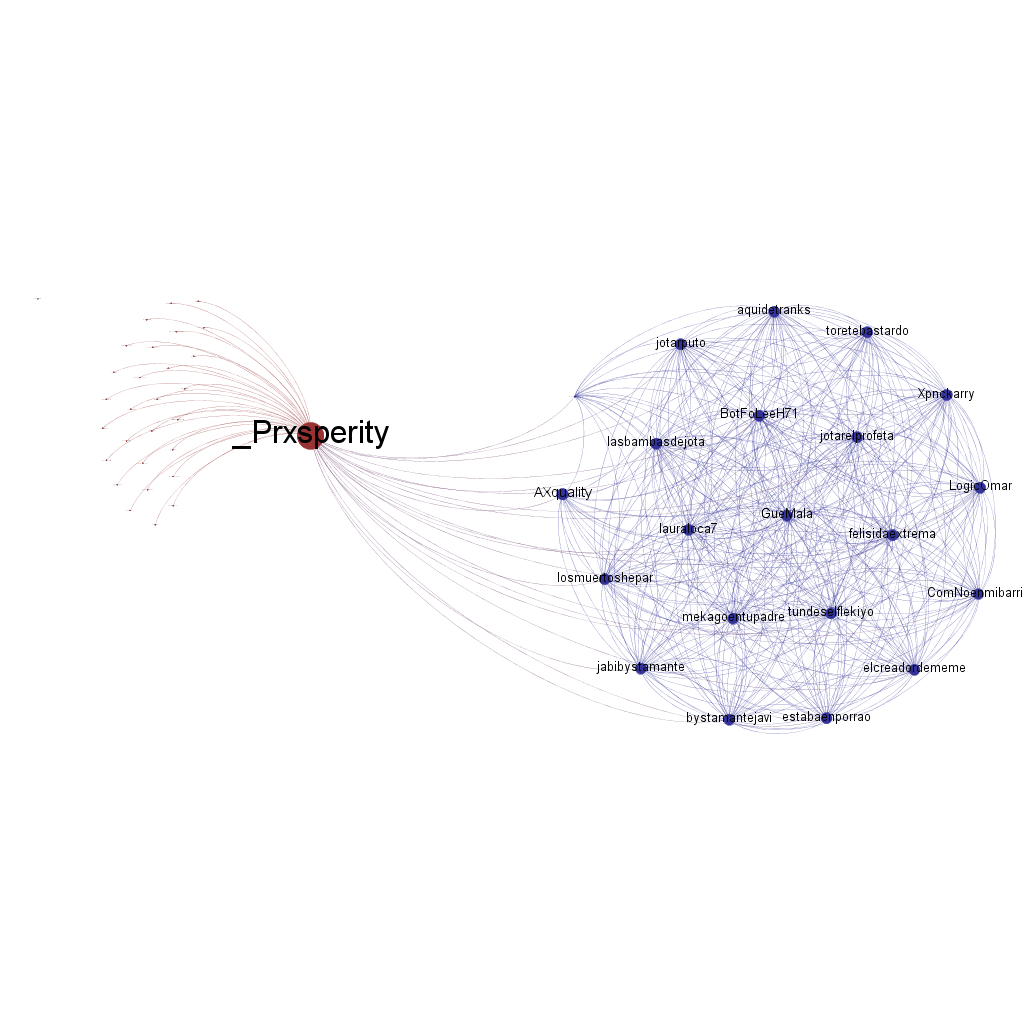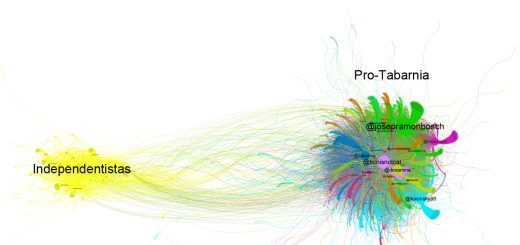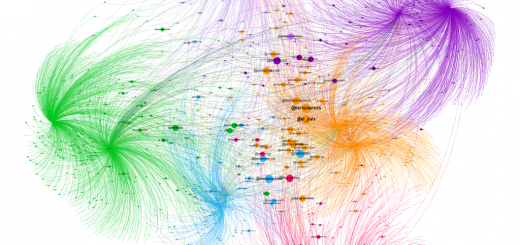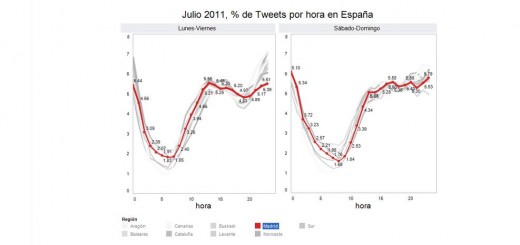A veces los hashtags los carga el diabloSometimes hashtags are loaded by the devil
No fue un buen día para la Agencia EFE el 25 de septiembre del 2014. Un poco antes de las diez de la mañana publicó un tweet con el hashtag #RajoyMariquita. Twitter le jugó una mala pasada al auto-completarle el hashtag #Rajoy. Aunque el tweet fue borrado casi al momento, no faltaron avezados usuarios de Twitter que hicieron una captura gráfica del mensaje. El usuario @martop tardó tan solo 12 segundos en hacerlo.
EFE on the face. #RajoyMariquita pic.twitter.com/QDAGjihGCY — martop (@martop) September 25, 2014
Al mediodía el hashtag #RajoyMariquita se convirtió en trending topic (TT) número uno en España, saltando a la prensa digital y dando lugar en Twitter a múltiples bromas y chascarrillos. Lo primero que me pregunté fue ¿por qué ha pasado? La curiosidad me pudo, aparqué lo que estaba haciendo para capturar los tweets y tirando del hilo encontré el origen del #hasthag. Todo comenzó a fraguarse cuando el usuario @SapoViolador intentó generar a las 16:00 del día 24 de septiembre el TT #RajoyMariquita, incitando a sus seguidores a usar el hashtag y contando con las ayuda de una batería de bots (no sé si suyos o del algún colega). No consiguió su objetivo pero Twitter tomó nota de este hastagh como posible tendencia y lo usó para auto-complementar el hashtag #Rajoy. Twitter no ha querido ser menos que Microsoft, con su odiado clip que se empeñaba en ayudarnos, o que Android que nos sugiere autenticas barbaridades cuando intentamos escribir con nuestros pulgares en el móvil. En este caso, el Algoritmo de Twitter proporcionó una ayuda envenenada.
A los amantes de las redes les encantará observar la simetría de la red de los bots participantes en el desaguisado. Imposible que tenga esta forma una red de usuarios reales.
Por falta de tiempo no analicé la propagación y hoy, cinco meses después he encontrado un momento para hacerlo. Me he dado cuenta de que estoy ocupada por encima de mis posibilidades, pero nunca es tarde si el análisis es bueno y en este caso he encontrado evidencias que confirman que el alcance no lo es todo.
En el siguiente gráfico vemos dos diagramas temporales de la publicación de tweets por minuto. En color azul Twitter corresponde a los tweets y en color gris el alcance (calculado como la suma de seguidores de los autores de los tweets). Cada uno de estos valores tiene su propia escala. En la parte superior tenemos la propagación global y en la inferior la propagación en España en la que se eliminaron los tweets, RTs y menciones de los usuarios: @la_patilla (Venezuela, 4,61 millones de seguidores), @PedroFerriz (México, 1,85 millones de seguidores), @AlbertoRavell (Venezuela 1,23 millones de seguidores), @BluRadioCo (Colombia, 1,11 millones de seguidores), @lajornadaonline (México, 923K seguidores).
La principal diferencia entre la propagación general y la propagación en España radica en el alcance, siendo hasta cuatro veces superior en el primer caso. Sin embargo, el volumen de tweets varía muy poco en ambos escenarios. Esto es debido a que la audiencia en Venezuela, Colombia y México no es tan receptiva como en España a la confusión del hashtag #RajoyMariquita. Es decir, un gran alcance es muy poco efectivo en una audiencia no interesada en el mensaje . Si observamos la propagación en España, vemos que cerca de la media noche del día 25 aparece un alcance muy alto, correspondiente a @daniMateoAgain (con 905K seguidores), que tiene poca repercusión. La causa puede ser que la audiencia estaba saturada con el tema. Es algo similar a lo ocurrido en la propagación del tweet del teletexto, en el que @pacoleonbarrios (1,17 millones de seguidores) y @JavierCapitan (104K seguidores) también tuitean al final de la jornada sin conseguir un gran impacto.
Resumiendo: El alcance funciona cuando las audiencias están en sintonía con el tema y pierde fuelle cuando la información no es actual.
Posiblemente muchos ya lo supieran pero pocos lo han pintado con tanto detalle como yo :-)
25th of September was a black day for the Spanish news agency EFE. It was almost ten o’clock when they posted a tweet with the hashtag #RajoyMariquita. It happened because Twitter auto-filled the hashtag #Rajoy with “Mariquita” (gay) and they pressed the tweet button without reading it. Although the tweet was deleted quickly, some users of Twitter made a graph capture and tweeted it. It took the user @martop only 12 seconds to do it.
EFE on the face. #RajoyMariquita
pic.twitter.com/QDAGjihGCY — martop (@martop) September 25, 2014
At noon the hashtag #RajoyMariquita became the number one trending topic (TT) in Spain, made headlines in digital newspapers and filled Twitter with jokes. I wondered, why it happened? I felt curious, I stopped what I was doing and I captured the tweets of this hashtag. Pulling the thread I found the hashtag source. It started when the user @SapoViolador (toad rapist) tried to generate at 16:00 on September 24 the TT #RajoyMariquita, inciting his followers to use the hashtag and helped by a set of bots (not sure if his or of a colleague). He did not achieve his objective but Twitter took note of this hastagh as a possible trend and used it to self-supplement #Rajoy hashtag. Twitter tried helping us like Microsoft, with its hated clip that was determined to help, or Android which suggests authentic atrocities when we try to write with our thumbs on mobile phones. In this case, the Twitter algorithm provided a poisoned help.
Fans of networks will love seeing bot’s relation symmetry, it was impossible it they were human users.
Due to lack of time I did not analyze the spread. Today, five months later, I found a moment to do so. I’ve noticed that I’m too busy, but it´s never too late if the analysis is good. In this case I have found evidence confirming that the reach is not enough to spread messages.
In the chart below we see two timing diagrams of the publication of tweets per minute. The blue Twitter line corresponds to tweets and the gray line to reach (calculated as the sum of followers of the authors of the tweets). Each of these values has its own scale. At the top we have the global spread and lower the propagation in Spain where the tweets, RTs and mentions of those users were deleted: la_patilla (Venezuela, 4.61 million followers), PedroFerriz (Mexico 1 85 million followers), AlbertoRavell (Venezuela 1.23 million followers), BluRadioCo (Colombia, 1.11 million followers), lajornadaonline (Mexico, 923K followers).
The main difference between the global spread and the propagation in Spain is the reach, four times bigger in the first case. However, the volume of tweets varies little in both scenarios. This is because the audience in Venezuela, Colombia and Mexico is not as responsive as in Spain to confusion #RajoyMariquita hashtag. That is, a large reach has low impact if the target is not encouraged in the message. If we look at the spread in Spain, we see that about midnight the 25th appears a very high reach, due to @DaniMateoAgain (with 905k followers), having little impact. The cause may be that the audience was saturated with it. It is similar to what happened in spreading tweet teletext, which @pacoleonbarrios (1.17 million followers) and @JavierCapitan (104K followers) also tweeted at night without getting a big impact.
In short: The reach works in an encouraged target and loses strength when the information is not current.
Possibly many already knew that but few have painted it in such detail as I have :-)




